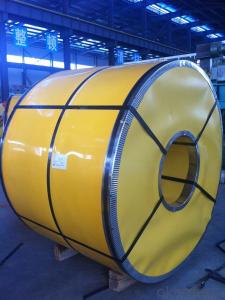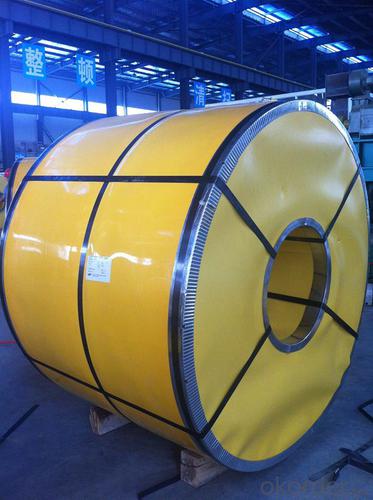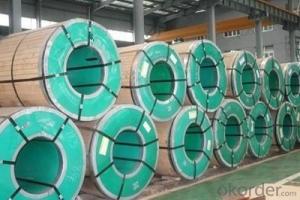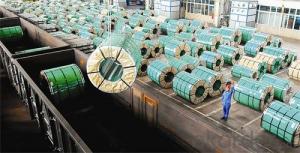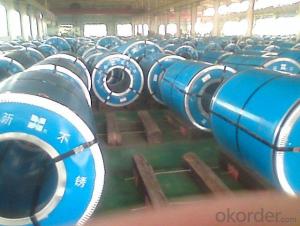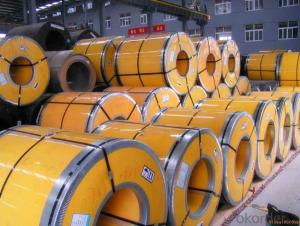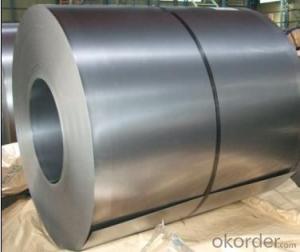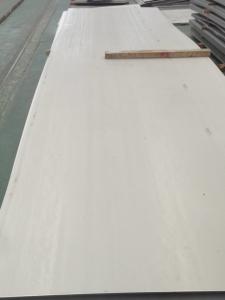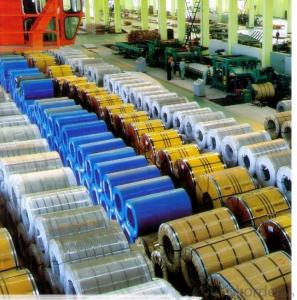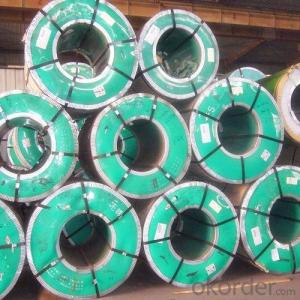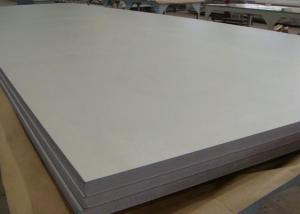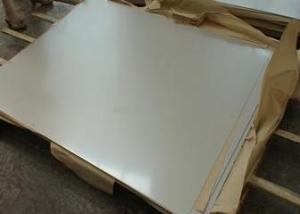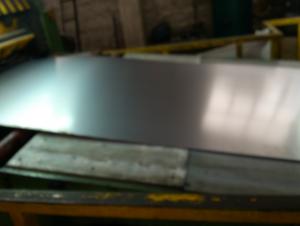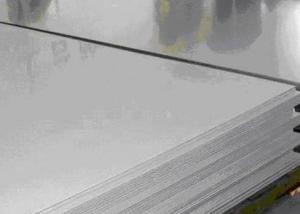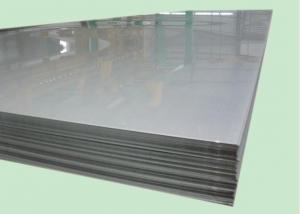Hot Rolled Stainless Steel Coil 304
- Loading Port:
- Qingdao
- Payment Terms:
- TT OR LC
- Min Order Qty:
- -
- Supply Capability:
- 5000 m.t./month
OKorder Service Pledge
OKorder Financial Service
You Might Also Like
Hot Rolled Stainless Steel Coil 304
Stainless steel is a production which not easy rust,acid resistance and corrosion resistance,so it is widely
used in light industry,heavy industry,daily necessities and the decoration industry.my company long-term
supply stainless steel porducts including:stainless steel sheet,stainless steel coil and stainless steel tube.
Specifications
1.surface:NO.1
2.standard:JIS, AISI, GB
3.width: 0.55m, 0.65m, 1.0m, 1.22m, 1.5m, 2.0m or requirement
ASTM 304
(%):C=0.07, Mn=2.00, P=0.045, S=0.030, Si=0.075, Cr=17.5-19.5, Ni=8.0-10.5, N=0.10
Physical Properties
Tensile strength σb (MPa) ≥ 520
the conditions yield strength σ0.2 (MPa) ≥ 205,
elongation δ5 (%) ≥ 40
Reduction of ψ (%) ≥ 50,
hardness: ≤ 187
HB; ≤ 90
HRB; ≤ 200H
Type | Hot Rolled Stainless Steel Coil 304 |
Thickness | 3.0mm-4.0mm |
Width | 550mm, 650mm, 1000mm, 1219mm, 1240mm, 1500mm |
Length | according to weight |
Brand name | CNBM |
Standard | ASTM, AISI, DIN, GB, JIS etc |
Material | 304 |
Application | Foodstuff, Gas, metallurgy, biology, electron, chemical, petroleum, boiler, nuclear energy, Medical equipment, fertilizer etc |
Package | Standard export sea-worthy packing |
Delivery time | Within 15 days since getting the deposit or LC origin |
Surface | NO.1 |
Productivity | 5000 tons/month |
- Q: What are the common chemical compositions of stainless steel strips?
- Stainless steel strips are typically composed of iron, chromium, and nickel. The most common chemical composition of stainless steel strips is 18% chromium and 8% nickel, known as 18/8 stainless steel. This composition provides excellent corrosion resistance, making stainless steel strips suitable for various applications, including kitchen utensils, automotive parts, and construction materials. Additionally, other elements such as carbon, manganese, and molybdenum may be present in smaller amounts to enhance specific properties such as strength, formability, and weldability. Overall, the chemical compositions of stainless steel strips can vary depending on the specific grade and intended use, but the presence of chromium and nickel is consistent across most stainless steel alloys.
- Q: Can stainless steel strips be used in the production of watches?
- Yes, stainless steel strips can indeed be used in the production of watches. Stainless steel is a popular material choice for watch cases, bands, and other components due to its durability, corrosion resistance, and aesthetic appeal. The strips can be precisely cut and shaped to create various watch parts, including cases, bezels, bracelets, and clasps. Stainless steel strips provide a sleek and polished look to watches and are highly versatile, making them suitable for both traditional and modern watch designs. Additionally, stainless steel is known for its strength and longevity, ensuring that watches made with stainless steel strips will be durable and withstand daily wear and tear.
- Q: Are stainless steel strips resistant to chloride stress corrosion cracking?
- Generally, stainless steel strips exhibit resistance to chloride stress corrosion cracking. The corrosion resistance properties of stainless steel are widely recognized, encompassing resistance to chloride stress corrosion cracking. This is attributed to the abundance of chromium in stainless steel, which generates a protective oxide layer on the material's surface, prohibiting the infiltration of chloride ions and subsequent corrosion. Nevertheless, it is vital to acknowledge that the resistance to chloride stress corrosion cracking may fluctuate depending on the specific stainless steel type and grade, as well as the environmental conditions in which the material is exposed. Thus, it is always advisable to refer to the manufacturer's specifications and guidelines to ensure the appropriate stainless steel grade is chosen for the intended application.
- Q: What is the formability of stainless steel strips?
- The formability of stainless steel strips is generally high, thanks to their inherent ductility and malleability. They can be easily bent, shaped, and formed into various complex shapes without fracturing or losing their structural integrity.
- Q: How do stainless steel strips resist chemical exposure?
- Stainless steel strips resist chemical exposure due to their unique composition and properties. Stainless steel is primarily made up of iron, chromium, and other alloying elements such as nickel and molybdenum. The presence of chromium in stainless steel forms a protective layer of chromium oxide on the surface, which acts as a barrier against chemical attack. This chromium oxide layer is highly stable and prevents the underlying metal from reacting with chemicals or corroding. It is this self-healing and passive nature of stainless steel that provides excellent resistance to various chemicals, including acids, alkalis, and corrosive substances. Additionally, stainless steel strips can be further enhanced to improve their chemical resistance by adjusting the composition or adding specific alloying elements. For example, increasing the nickel content can enhance resistance to certain acids, while adding molybdenum can improve resistance to chloride-containing environments. Furthermore, stainless steel strips can be treated with various surface finishes or coatings to provide additional protection against chemical exposure. These treatments can include passivation, electropolishing, or applying specialized coatings that offer enhanced chemical resistance. Overall, the combination of the inherent composition and the ability to customize stainless steel strips makes them highly resistant to chemical exposure, making them suitable for a wide range of applications in industries such as chemical processing, pharmaceuticals, food processing, and more.
- Q: How does the price of stainless steel strips compare to other materials?
- The cost of stainless steel strips can fluctuate based on the particular grade and size of the strip, as well as the current state of the market. However, in general, stainless steel strips are typically pricier compared to alternative materials. This is primarily due to the higher expenses associated with production and the distinctive characteristics of stainless steel. Stainless steel is renowned for its exceptional resistance to corrosion, durability, and strength. It is also highly tolerant to heat and physical damage, making it suitable for a wide array of applications in various industries. These superior qualities contribute to the elevated price of stainless steel strips in comparison to other materials. On the other hand, materials such as carbon steel or aluminum are generally more economical. Carbon steel strips are extensively utilized due to their lower production costs and satisfactory strength properties. Aluminum strips, conversely, are lightweight and possess good corrosion resistance, but they are less robust and durable than stainless steel. When contemplating the price of stainless steel strips, it is crucial to assess the specific requirements of the intended use. Although stainless steel may necessitate a higher upfront investment, its long-term advantages, such as an extended lifespan and decreased maintenance costs, can make it a more cost-effective choice in many instances. Ultimately, numerous factors, including market demand, raw material availability, and manufacturing processes, influence the price of stainless steel strips. It is advisable to consult with suppliers or industry experts to obtain accurate and up-to-date pricing information for stainless steel strips and compare it with other materials in order to make an informed decision.
- Q: Are stainless steel strips suitable for pressure piping?
- Yes, stainless steel strips are suitable for pressure piping. They have high strength, excellent corrosion resistance, and can withstand high pressure environments, making them a reliable choice for various applications in pressure piping systems.
- Q: Can stainless steel strips be used in the production of jewelry?
- Yes, stainless steel strips can be used in the production of jewelry. Stainless steel is a durable and corrosion-resistant material, making it suitable for jewelry that needs to withstand daily wear and tear. It can be used to create various types of jewelry, including rings, bracelets, necklaces, and earrings. Stainless steel strips can be easily shaped, engraved, or textured to create unique and intricate designs. Additionally, stainless steel jewelry is affordable compared to other precious metals, making it an attractive option for both consumers and jewelry makers.
- Q: How do you determine the mechanical properties of a stainless steel strip?
- Several testing methods can be utilized to determine the mechanical properties of a stainless steel strip. Tensile testing is a commonly employed method wherein the strip is subjected to an increasing load until it reaches its breaking point. This test allows for the measurement of stress and strain experienced by the strip, enabling the determination of properties like yield strength, ultimate tensile strength, and elongation. Another method involves hardness testing, which evaluates the strip's resistance to indentation or penetration by a hard object. Rockwell, Brinell, and Vickers hardness tests are some examples of common methods used. The results obtained from these tests provide crucial information about the material's hardness, a significant mechanical property. To assess the toughness of the stainless steel strip, impact testing can be conducted. This test involves striking the strip with a pendulum or hammer and measuring the amount of energy absorbed before fracture occurs. The impact test sheds light on the material's ability to withstand sudden loading or shock. Bending tests can be performed to evaluate the strip's ductility and flexibility. This test requires subjecting the strip to a specified radius of curvature and observing its behavior. By measuring the force required to bend the strip to a specific degree, its bendability, elasticity, and fracture resistance can be determined. Specialized tests designed to simulate real-world conditions can assess other mechanical properties such as fatigue strength, creep resistance, and corrosion resistance. These tests typically expose the strip to cyclic loading, elevated temperatures, or corrosive environments while monitoring its performance over time. In conclusion, the determination of mechanical properties in a stainless steel strip involves a range of testing methods, including tensile testing, hardness testing, impact testing, bending tests, and specialized tests for specific properties. These tests provide crucial information about the strip's strength, hardness, toughness, ductility, and resistance to different forms of stress and environmental factors.
- Q: What are the factors affecting the corrosion resistance of 111 stainless steel strips?
- The factors affecting the corrosion resistance of 111 stainless steel strips include the composition of the stainless steel, the presence of impurities, the surface finish, the temperature and environment in which it is exposed, and the presence of corrosive substances such as acids or salts.
Send your message to us
Hot Rolled Stainless Steel Coil 304
- Loading Port:
- Qingdao
- Payment Terms:
- TT OR LC
- Min Order Qty:
- -
- Supply Capability:
- 5000 m.t./month
OKorder Service Pledge
OKorder Financial Service
Similar products
Hot products
Hot Searches
Related keywords
